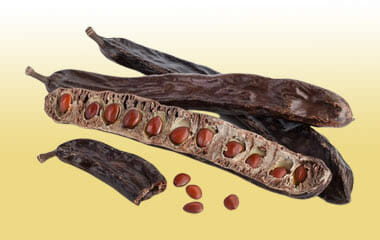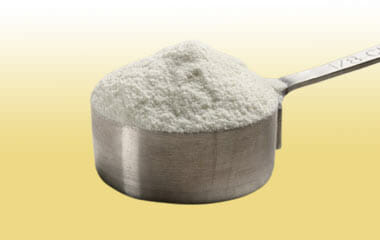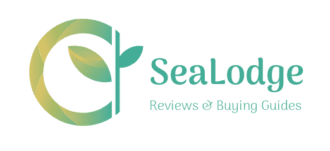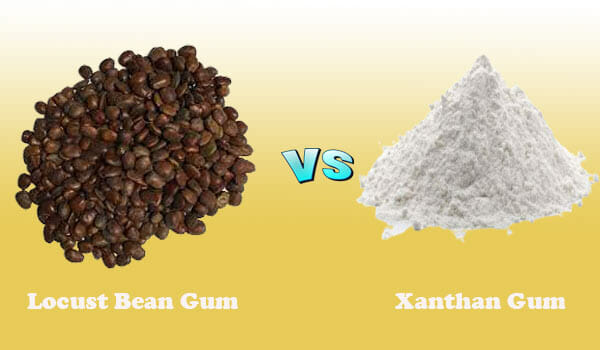Love preparing gluten-free food products? Or perhaps, you are looking for a natural and safe food thickener? If yes, locust bean gum and xanthan gum are some of the most popular substances you can use. This is because you can use both as stabilizers, emulsifiers, and thickeners.
Besides that, they offer a range of health benefits thanks to their fiber-rich content, including improving blood sugar levels. But while both have the same applications, they are not completely the same.
They differ in terms of chemical structure, solubility, pH, viscosity, and how they are made. Therefore, knowing which gum is best for your cooking needs can be daunting.
But don’t worry because we’ve put together a guide to help you understand what each gum does and its application. So let’s see how locust bean gum vs. xanthan gum compare against each other!!!
Locust Bean Gum Structure - Definitive Guide

Locust bean gum (LBG) or carob gum is a vegetable-based thickener belonging to a group of polysaccharides popularly known as galactomannans. These polysaccharides have a chain-like molecular structure comprising polymeric mannose chain and galactose units.
The main mannose chain consists of (1,4) beta-D linked mannose residues. But it just does not end there. As it turns out, every fourth mannose unit is further broken down to a small side chain comprising linked (1,6) alpha-D galactose sugar. So, overall, you will find that there are approximately 4 mannose residues in every galactose residue.
Overall, unlike the mannose units, the galactose sugars are not uniformly dispersed along the chain. Instead, you will realize that they are clustered in blocks. For this reason, the LBG structure is not ‘smooth’ but irregular with substituted zones.
Application of Locust Bean Gum
The carob bean gum is quite popular, perhaps because of its many food applications. Some of its frequent applications include:
Thickener
As a thickener, locust bean gum helps improve the texture of various food items. For instance, you can use it in ice cream to ensure it does not melt down quickly. You can also use it in salad dressings and sauces for an improved texture.
Stabilizer
Additionally, this gum acts as an excellent stabilizer in food products such as ice creams, cream cheese, and dairy desserts. For example, if you use it in ice creams, it helps inhibit the growth of ice and lactose crystals. This comes in handy, especially when temperatures fluctuate.
Fat replacer
In the dairy industry, LBG is one common ingredient you are likely to find. Basically, it helps prevent fat loss in your favorite dairy products, including milk, during the freezing and thawing process.
Natural additive
This gum is also considered to be a safe additive and is actually FDA-approved. As an additive, you are likely to spot it in infant formulas and various vegan recipes.
Pet food
As it turns out, this gum is also used in making wet pet food as a stabilizer, gelling and binding agent. In other words, the gum helps trap the moisture, so the food remains wet.
What Does Locust Bean Gum Do?
Now that you know the different applications of carob gum let’s find out what exactly it does.
Thickening food
This gum boasts unique characteristics, including a pH-independent thickening effect like guar gum. What the gum does is create high viscosity or improve the texture of different products. Consequently, this ensures your food stays as thick as it is necessary.
Lowers blood sugar
LBG is rich in fiber. Because of this, different studies suggest that it can help reduce blood sugar levels. This is by minimizing your body’s ability to absorb sugars and carbs in the food.
Reduces symptoms of reflux
Another thing that carob bean gum does is thicken an infant’s formula. This helps ensure the milk does not rise back into your baby’s esophagus, thereby preventing reflux. The gum can also reduce intestinal problems in babies by slowing down gastric emptying.
Improves digestion
Since this gum is made of high fiber content, it is very good for your gut health. Basically, it can help prevent constipation. In addition, the gum contains a compound called pectin that has been shown to relieve diarrhea.
Xanthan Gum Structure - Is It Good to Buy for Home Use?

Xanthan gum is a hydrocolloid or a natural polysaccharide with high molecular weight. The gum is produced through the fermentation of simple sugars. However, compared to the locust bean gum, you will find the xanthan gum structure a little complex.
The structure of this gum comprises (1,4) linked beta-D glucose residues, which is similar to cellulose. And each alternate glucose residue consists of a (3,1) trisaccharide side chain.
Further, this side chain is substituted to produce (2,1) mannose residues with glucuronic acid residue linking them together. In addition to this, on every alternating glucuronic residue, you get (4,1) beta-D-mannopyranose.
But that’s not all because the mannose near the main chain may carry a C6 acetyl group. On the other hand, there is the terminal mannose that contains a (4-6) pyruvate group. So, overall, xanthan gum usually forms a fivefold helical structure.
Application Of Xanthan Gum
Similar to carob gum, this gum also boasts a wide range of applications. Of course, this is thanks to its thickening, stabilizing, and emulsifying properties. Its applications include:
Food products
You can use this gum to improve the consistency, texture, appearance, and even flavor of different types of foods. In addition to this, you can use it as a stabilizer to prevent ingredients from separating.
Some of the common foods containing this gum include soups, salad dressings, fruit juices, sauces, ice creams, and gravies. You will also find it in meat and poultry products, beverages, bakery products, dairy, and confectionery products.
Cosmetic products
Apart from food applications, xanthan gum is also widely used in cosmetic and personal care products.
Simply, it helps thicken these products while allowing them to flow out easily. You can find it in products like toothpaste, shampoo, creams, lotions, and liquid makeup.
Industrial application
Xanthan gum can easily withstand different pH and temperature levels. Because of this and its ability to thicken liquids, it is widely used in various industrial products.
You will find it in products like insecticides, fungicides, paints, oil drilling fluids, polishes, cleansers, and varnishes.
What Does Xanthan Gum Do?
Not sure whether or not it would be a good idea to buy xanthan gum for home use? Below are some of the things this gum can do.
Better digestion
Xanthan gum is a soluble fiber. So, what it does is that it draws water into your gut. As a result, this helps soften your stools, thereby reducing constipation while also increasing the frequency of passing stool.
Lower or stabilize blood sugar
According to different studies, the gum works by turning the fluids in your small intestine and stomach into a viscous and gel-like substance. Consequently, this helps slow down digestion and affects how fast sugar enters your bloodstream.
Thickening liquids
Patients with conditions such as stroke or any neurological disorder tend to have difficulties swallowing thin liquids. What this gum does is thicken these liquids for ease of swallowing without choking.
Treating dry mouth
For individuals suffering from chronic dry mouth, xanthan gum is one of the most effective solutions. It works as a safe saliva substitute to ensure moisture stays locked in.
Safe gluten alternative
If you are intolerant to foods containing gluten, you can consider foods made with xanthan gum. This gum helps thicken baked-food products without the unpleasant symptoms associated with gluten, including diarrhea and stomach pain.
Locust Bean Gum Vs. Xanthan Gum: What's The Differences Between Them?
While these two additives are used as thickeners, stabilizers, and emulsifiers, they are not equally the same. So, read on to find out their key differences.
How they are made
Locust bean gum is a vegetable-based product derived from the carob tree. This explains why it is also referred to as carob gum. The gum is extracted from the seeds of this tree.
As such, it is made mainly of carbs but in fiber form. Interestingly, it also contains sodium, protein, and calcium but in small quantities. Meanwhile, xanthan gum is not naturally found in plants like locust bean gum.
It is instead manufactured in the lab through the fermentation process. What happens is that sugars in sucrose or glucose form are fermented with a bacteria called Xanthomonas campestris.
Sugars can come from a variety of sources, including corn, dairy, wheat, and soy. On the other hand, the bacteria used occurs naturally on plants such as cabbages.
Solubility and viscosity
You cannot dissolve carob gum in cold water as it is completely insoluble. But in room-temperature water, this gum is slightly soluble. So, if you want to achieve maximum solubility with this gum, you must heat it to about 85 degrees Celsius or more.
In other words, LBG is only hot soluble. As such, it has a lower viscosity. When it comes to xanthan gum, you can completely dissolve it in cold water to achieve an even solution.
Simply put, the gum has better water solubility properties than locust bean gum. As a result, it boasts high viscosity even at lower concentrations.
Therefore, with LBG, you must use a higher dosage to achieve the same high level of viscosity as that of xanthan gum.
pH stability
When you dissolve carob bean gum in hot or cold water, it forms a solution with a pH between 5.4 and 7.0. However, this gum does not have good pH stability in highly acidic conditions.
Compared to locust bean gum, xanthan gum offers better pH stability. Basically, this gum is stable in various applications with a range of pH values between 2.0 and 12.0. In other words, it is more tolerant to salts, heat, and enzymes.
Structure
LGB structure is pretty simple, similar to that of guar gum. It only includes a polymeric mannose chain substituted with galactose units. However, the main chain comprises (1,4) beta-D linked mannose residues while the side chain consists of (1, 6) alpha-D linked galactose.
As for xanthan gum’s structure, you might find it somewhat complicated. This is because it forms a fivefold helical structure.
Basically, the gum comprises a linear (1, 4) beta-D backbone of glucose with trisaccharide side chains on each glucose sub-unit. This explains why it is completely soluble in water and has excellent viscosity.
Gel formation
Unfortunately, locust bean gum does not gel on its own. It usually swells almost fully when you dissolve it in cold water, thereby forming a highly viscous formula.
Therefore, if you want to form a gel, you must combine your gum with other hydrocolloids like xanthan gum and agar. Also, kappa carrageenan gum addition to your LGB can work.
Because of its excellent solubility properties, xanthan gum can gel by itself. It dissolves completely in water to form a gel structure that is sparkling clear or shears thinning. But for better effects, you can add LBG, and your gel will be stronger and thicker.
Is Locust Bean Gum Good for you?
Locust bean gum is generally a safe food additive since it is an all-natural substance. The gum is actually FDA approved for use as a food additive.
And when taken in moderation, it can help improve your blood sugar levels and digestion. So, overall, LGB is good for you.
Even so, you might develop an allergic reaction to gum-like breathing issues and asthma.
Is Xanthan Gum Good for you?
Like locust bean gum, xanthan is also safe when used as an additive and in the right amounts. It is also FDA approved and could help reduce your blood sugar levels, treat dry mouth, and improve digestion.
However, if you consume it in excess, you may suffer from intestinal gas and even bloating. So, you must not consume more than 15 grams of xanthan gum per day.
Conclusion
Both locust bean gum and xanthan gum are some of the best food additives and thickeners you can find. They are safe and boast a wide range of applications.
Not to mention, you can always combine the two to achieve a thicker and more effective gel. Even so, these two polysaccharides differ in so many ways. For instance, xanthan is more soluble in water and has high viscosity than its locust bean counterpart.
On the other hand, locust bean gum has a shorter chain than xanthan gum. If that’s not enough, xanthan gum is lab-made, while LGB is naturally derived from plants.
Also read:
SeaRanchLodge.com is a participant in the Amazon Associate program and will earn from qualifying purchases.


